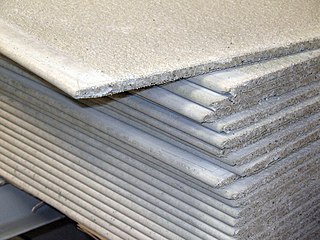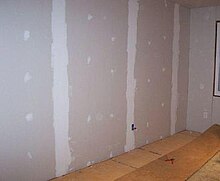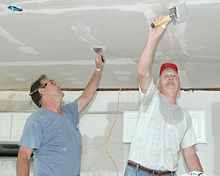
Mortar is a workable paste which hardens to bind building blocks such as stones, bricks, and concrete masonry units, to fill and seal the irregular gaps between them, spread the weight of them evenly, and sometimes to add decorative colors or patterns to masonry walls. In its broadest sense, mortar includes pitch, asphalt, and soft mud or clay, as those used between mud bricks, as well as cement mortar. The word "mortar" comes from Old French mortier, "builder's mortar, plaster; bowl for mixing." (13c.).

Plaster is a building material used for the protective or decorative coating of walls and ceilings and for moulding and casting decorative elements. In English, "plaster" usually means a material used for the interiors of buildings, while "render" commonly refers to external applications. The term stucco refers to plasterwork that is worked in some way to produce relief decoration, rather than flat surfaces.

Drywall is a panel made of calcium sulfate dihydrate (gypsum), with or without additives, typically extruded between thick sheets of facer and backer paper, used in the construction of interior walls and ceilings. The plaster is mixed with fiber ; plasticizer, foaming agent; and additives that can reduce mildew, flammability, and water absorption.

Calcium sulfate (or calcium sulphate) is the inorganic compound with the formula CaSO4 and related hydrates. In the form of γ-anhydrite (the anhydrous form), it is used as a desiccant. One particular hydrate is better known as plaster of Paris, and another occurs naturally as the mineral gypsum. It has many uses in industry. All forms are white solids that are poorly soluble in water. Calcium sulfate causes permanent hardness in water.

USG Corporation, also known as United States Gypsum Corporation, is an American company which manufactures construction materials, most notably drywall and joint compound. The company is the largest distributor of wallboard in the United States and the largest manufacturer of gypsum products in North America. It is also a major consumer of synthetic gypsum, a byproduct of flue-gas desulfurization. Its corporate offices are located at 550 West Adams Street in Chicago, Illinois.

Lath and plaster is a building process used to finish mainly interior dividing walls and ceilings. It consists of narrow strips of wood (laths) which are nailed horizontally across the wall studs or ceiling joists and then coated in plaster. The technique derives from an earlier, more primitive process called wattle and daub.

A drywall mechanic is a skilled trade similar to wood carpenters, except they build everything out of light gauge steel studs all year round, regardless of weather conditions. Drywall mechanics erect various exterior and interior stud wall partitions. They also install metal door frames, window frames, a variety of acoustical ceilings, and precast moldings for columns and ceilings. In addition, they also install x-ray shielding, thermal and sound insulation and a variety of drywall panels and metal and vinyl trims.

A lath or slat is a thin, narrow strip of straight-grained wood used under roof shingles or tiles, on lath and plaster walls and ceilings to hold plaster, and in lattice and trellis work.

Lime plaster is a type of plaster composed of sand, water, and lime, usually non-hydraulic hydrated lime. Ancient lime plaster often contained horse hair for reinforcement and pozzolan additives to reduce the working time.

Plasterwork is construction or ornamentation done with plaster, such as a layer of plaster on an interior or exterior wall structure, or plaster decorative moldings on ceilings or walls. This is also sometimes called pargeting. The process of creating plasterwork, called plastering or rendering, has been used in building construction for centuries. For the art history of three-dimensional plaster, see stucco.

A plasterer is a tradesman or tradesperson who works with plaster, such as forming a layer of plaster on an interior wall or plaster decorative moldings on ceilings or walls. The process of creating plasterwork, called plastering, has been used in building construction for centuries. A plasterer is someone who does a full 4 or 2 years apprenticeship to be fully qualified.

Lime mortar or torching is a masonry mortar composed of lime and an aggregate such as sand, mixed with water. It is one of the oldest known types of mortar, used in ancient Rome and Greece, when it largely replaced the clay and gypsum mortars common to ancient Egyptian construction.
Wood putty, also called plastic wood, is a substance used to fill imperfections, such as nail holes, in wood prior to finishing. It is often composed of wood dust combined with a binder that dries and a diluent (thinner), and, sometimes, pigment. Pore fillers used for large flat surfaces such as floors or table tops generally contain silica instead of or in addition to wood dust. Pores can also be filled using multiple coats of the final finish rather than a pore filler.

Spackling paste or spackle is a putty used to fill holes, small cracks, and other minor surface defects in wood, drywall, and plaster. Typically, spackling is composed of gypsum plaster from hydrated calcium sulfate and glue.

Knockdown texture is a drywall finishing style. It is a mottled texture, it has more changes in textures than a simple flat finish, but less changes than orange peel, or popcorn, texture.

A cement board is a combination of cement and reinforcing fibers formed into sheets, of varying thickness that are typically used as a tile backing board. Cement board can be nailed or screwed to wood or steel studs to create a substrate for vertical tile and attached horizontally to plywood for tile floors, kitchen counters and backsplashes. It can be used on the exterior of buildings as a base for exterior plaster (stucco) systems and sometimes as the finish system itself.
Plaster veneer or plaster skim is a construction methodology for surfacing interior walls, by applying a thin layer of plaster over a substrate—typically over specially formulated gypsum board base, similar in nature to drywall.
Plaster mold casting is a metalworking casting process similar to sand casting except the molding material is plaster of Paris instead of sand. Like sand casting, plaster mold casting is an expendable mold process, however it can only be used with non-ferrous materials. It is used for castings as small as 30 g (1 oz) to as large as 7–10 kg (15–22 lb). Generally, the form takes less than a week to prepare. Production rates of 1–10 units/hr can be achieved with plaster molds.
Acoustic plaster is plaster which contains fibres or aggregate so that it absorbs sound. Early plasters contained asbestos, but newer ones consist of a base layer of absorptive substrate panels, which are typically mineral wool, or a non-combustible inorganic blow-glass granulate. A first finishing layer is then applied on top of the substrate panels, and sometimes a second finishing layer is added for greater sound attenuation. Pre-made acoustic panels are more commonly used, but acoustic plaster provides a smooth and seamless appearance, and greater flexibility for readjustment. The drawback is the greater level of skill required in application. Proprietary types of acoustic plaster developed in the 1920s included Macoustic Plaster, Sabinite, Kalite, Wyodak, Old Newark and Sprayo-Flake produced by companies such as US Gypsum.

Gypsum block is a massive lightweight building material composed of solid gypsum, for building and erecting lightweight, fire-resistant, non-load bearing interior walls, partition walls, cavity walls, skin walls, and pillar casing indoors. Gypsum blocks are composed of gypsum, plaster, water and in some cases additives like vegetable or wood fiber for greater strength. Partition walls, made from gypsum blocks, require no sub-structure for erection and gypsum adhesive is used as bonding agent, not standard mortar. Because of this fundamental difference, gypsum blocks shouldn't be confused with the thinner plasterboard used for paneling stud walls.

















